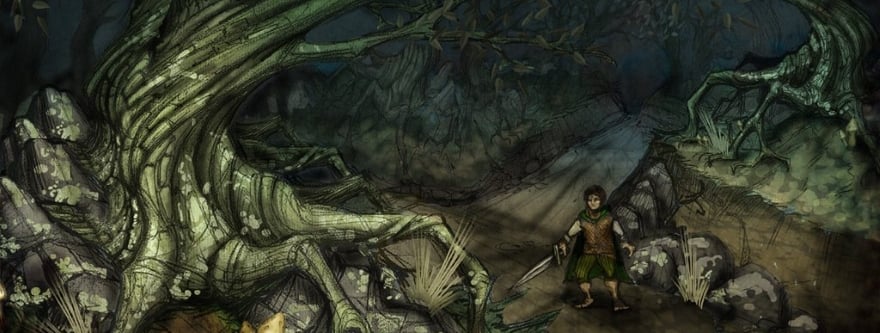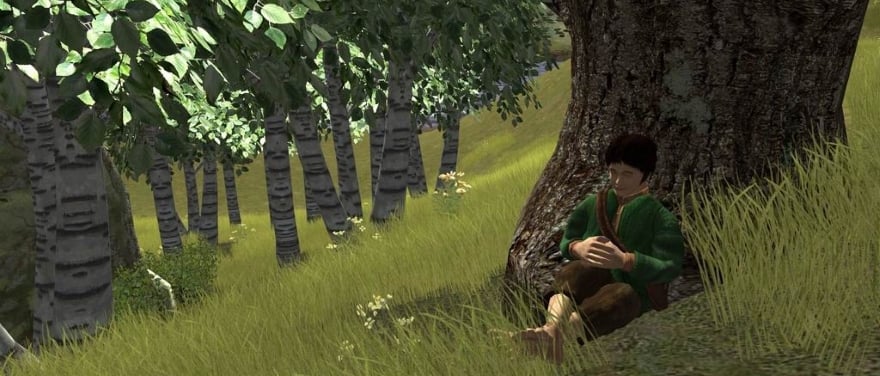
Out of all of the MMOs that I’ve played over the years, I must have spent the most time in Lord of the Rings Online’s wonderfully realized vision of J.R.R. Tolkien’s world. An early magazine article in 2007 intrigued me with the mention of a “low-fantasy” MMO that skewed more to realism than the cartoony World of Warcraft. By the time the head start period had finished, I was in love with the Shire, Hobbits, and ordering my Lore-master’s raven to peck the eyes out of goblins.
Yet the MMO that I’ve played and enjoyed was a title born in the grave of a previous effort to bring Lord of the Rings to MMOs: Middle-earth Online. Turbine wasn’t the first MMO studio to take a crack at Tolkien’s license. No, for that we have to travel back to 1998 and revisit Sierra On-Line. It was this company that had a brief but memorable run designing Middle-earth Online with features such as permadeath. It’s a fascinating glimpse into an entirely different approach to the IP, and even though it fizzled out due to a number of factors, I think it’s important it be remembered. Frodo lives!
 From the house that adventure games built
From the house that adventure games built
Older PC gamers will undoubtedly remember Sierra On-Line fondly; I know I do. Best known for its commanding adventure games like King’s Quest and Space Quest (really, anything with the word “Quest” in the title), Sierra grew to be a major player in the development and publishing scene over the ’80s and ’90s.
In 1997, Sierra’s Craig Alexander looked at the moderate success of The Realm Online and wondered how successful a similar game might be if it had a powerhouse IP behind it. The notion of licensing the works of Tolkien popped into his head, and he told the team to pursue it.
Initially, the game was going to use The Realm Online’s server code and be presented in a 2-D isometric format (which was eventually changed to top-down 3-D). Doing it right would cost over $5 million, which was a massive sum at the time for an unproven genre. Writer Daniel James (Puzzle Pirates) shared the lofty goal of the project while discussing the then-new website features: “In time, the site will feature extensively the game’s art which
is presently under wraps and material direct from the world and its players, all the while adhering to our central mission: to create a true rendering of Professor Tolkien’s classic work.”
Alas, Sierra was not long for this world by the time it acquired the license to develop a Lord of the Rings MMO. The team began work on Middle-earth Online (MEO) in 1998 while aiming for a 2000 release. However, it was already facing huge problems following massive layoffs and a studio relocation when Sierra On-Line was sold to Vivendi. By all accounts, the project suffered from a lack of dedicated management, which added to this atmosphere of instability. After MEO relocated from California to Washington in 1999, not much was heard from the new team aside from legal issues surrounding the license.
Even as the project limped forward, the original team’s vision for the game was all but finished at this point. Instead of rampaging orcs, accountants and legal departments conquered the lands of the Free People of Middle-earth. Vivendi Universal took over the license in 2001, farming out the development to Turbine Entertainment by 2003. Turbine struggled with the “obsolescent mess” of MEO before starting over in 2004, securing the full MMO rights in 2005, and launching the game in 2007.
“I actually began to think the license was cursed like the One Ring, and that the game would never ship,” Senior Designer Janus Anderson (NCsoft, Disney Mobile) later said. “I do think that spectacularly bad decisions were made, and an absence of leadership was demonstrated by some people who should have led. In the end, though, the actual decision-making process was so convoluted that I wouldn’t hold any individuals to blame.”
That’s how the story of Middle-earth Online ends. But what if MEO had gone forward? What would it have looked like? Let’s find out!
 Into the Fourth Age
Into the Fourth Age
Unlike Lord of the Rings Online, whose approach was to send players on a parallel journey of sorts with the Fellowship during the time of the books, MEO was to take place after the events of the trilogy. Set a couple generations into the Fourth Age, this MMO would try to answer the question “what happened next?”
Middle-earth Online was designed as far more of a sandbox experience than its themepark descendant. The idea was to let you live a virtual life in Middle-earth by choosing your path, whether it be hunting down other players or setting up shop as a crafter.
“I believed in the sandbox school of MMP design,” Daniel James wrote. “Give the players the tools and a rich environment in which to exercise them. This part of the design did a complete 180, much to my delight.”
To cut down on the amount of content creation the limited team had to do, the devs designed MEO’s systems to let the players shape the world such as build and destroy structures and random adventures would be generated for those looking to quest.
The team bandied about other concepts such as having player characters automatically flee from deadly fights and be capturable by NPCs, which would necessitate a rescue from friends. Characters were planned to have a “psychology” that could be modified by players through repeated or deliberate actions. Making loud noises would have attracted bad guys. And in probably one of my personal favorite ideas, the team said that it would limit the number of Elven players to keep the numbers in line with the diminishing population according to the official lore.
With EverQuest coming out during the development process of Middle-earth Online, some of the higher-ups thought that MEO could benefit from adapting EQ’s features, such as an increased emphasis on magic and far more Elves. While the team resisted these changes, the project was almost at an end anyway.
Lead Developer Stephen Nichols (The Realm Online, Dungeon Runners) still had strong feelings about the subject years after the fact: “Can you believe the nerve? The overlords wanted to take this wonderful work of art by J.R.R. Tolkien and package it as a hack-and-slash game?! I was horrified by this turn of events. Many of us on the team were. That’s not what we signed up for! How could I live with myself after promising that I’d keep true to Tolkien’s works? In short, I couldn’t. I resisted every attempt to change the game’s vision into a world where Gandalf is a dime-a-dozen and Hobbits are hurling fireballs.”
 One life, one death
One life, one death
Of course, whenever anyone mentions Middle-earth Online, it’s usually followed by “wasn’t that going to have permadeath?” in the next breath. Indeed, one of the team’s biggest visions for MEO was to permanently kill your character in certain situations.
If you think this was a bad idea, you’re in good company with MEO Programmer Joe Ludwig, who commented, “Some of the ideas actually survived into the game that Turbine eventually shipped, but some were what I like to call ‘crazy.’ The biggest of those was permadeath. The high level design here was that any player would be able to work up the nerve to commit murder by way of lesser crimes. Eventually they would be able to permanently kill another player’s character. Certain high level monsters would also have the ability to permakill a player character. To be fair, this was 1999. EverQuest hadn’t launched when we relocated, and things like permadeath were considered debatable. In retrospect, though, that one just seems crazy.”
According to James, permadeath wouldn’t have been that common, and only players who made conscious decisions to be branded “murderers” would be fair game for such an act. PvP would have been broader than that, however, with the ability to play as a free-roaming servant of Sauron. The devs would pitch monster play progression by saying that the more you leveled up, the bigger and badder you became, but then you’d start to become tied to locations.
A former Turbine employee claims that this original vision for Middle-earth Online wouldn’t have flown with the Tolkien estate, especially in allowing player characters to become evil. “The Tolkien guidelines (which by the way I sorely wished I’d taken a copy of, they were interesting reading) were very clear that players were not to be evil or commit evil acts,” he wrote.
So it’s entirelly possible that even if Middle-earth Online’s development had proceeded without studio intervention, it would have faced an insurmountable obstacle when faced with the owners of the IP. Personally, I’m very happy with how LOTRO turned out, imperfect as it is.
You can check out a 2003-era trailer for Middle-earth Online (which was by then starting to look more like the LOTRO we know today) below:
 Believe it or not, MMOs did exist prior to World of Warcraft! Every two weeks, The Game Archaeologist looks back at classic online games and their history to learn a thing or two about where the industry came from… and where it might be heading.
Believe it or not, MMOs did exist prior to World of Warcraft! Every two weeks, The Game Archaeologist looks back at classic online games and their history to learn a thing or two about where the industry came from… and where it might be heading.














